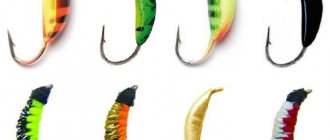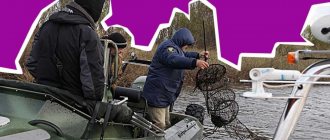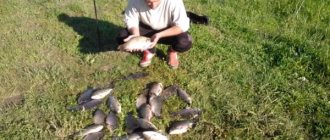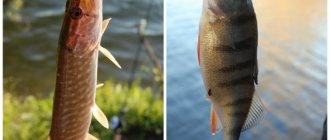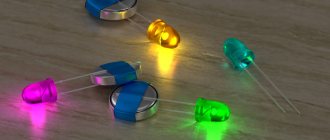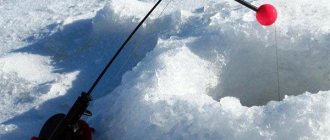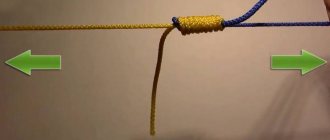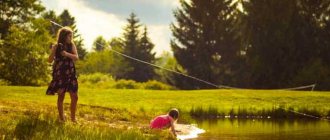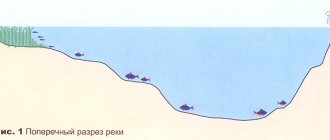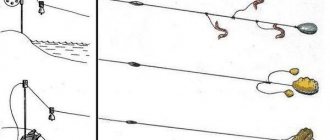Sea fishing
- This is a special type of fishing.
The differences between sea fishing and regular fishing are quite significant, from the object of the hunt to the gear. The diversity of marine life makes fishing at sea
very exciting and varied. Often, it is almost impossible to predict who will grab the bait. Gear used for sea fishing is subject to special requirements for reliability and durability, and baits are comparable in size to quite decent freshwater fish. In a word, sea fishing is a very exciting business. Just look at the names of trophy fish such as “marlin”, “shark” or “barracuda”. But we should not forget that the winds at sea also generate waves that cannot be compared with the waves on even the largest rivers and reservoirs.
Features of sea fishing
Sea fishing Sea fishing
is significantly different from fishing in fresh water. First of all, of course, one is struck by the huge size of the sea, the sound of the surf, the high transparency of the water, the originality of the underwater terrain and the diversity of fish species. The depths of the sea are much more densely populated than freshwater bodies, and the struggle for existence here is tougher. Marine fish are therefore more mobile, active, aggressive, and in clear water they see prey much further. All this makes fishing exciting and requires certain skills. It requires special gear and devices. Fish in the sea is caught almost all year round, except during storms, and where ice sets in in winter, fishing with winter gear can be very productive.
The behavior of marine fish, like freshwater fish, is highly dependent on weather conditions, and many react sharply to changes in atmospheric pressure. For example, a goby, in the face of weather changes that even meteorological instruments are not yet able to detect, becomes phlegmatic, indifferent to the bait, and if frightened, it will hide under the nearest stone.
The best time for sea fishing is considered to be summer with stable warm weather, moderate wind and lack of precipitation. The main thing is that there are no sudden temperature changes and changes in wind directions. An increase in wind, which causes strong waves to rise, forces most fish to move further into the sea, and coastal invertebrates hide in silt, sand, crawl under stones, and look for any possible shelter. But as soon as the weather improves and the sea calms down, you can go fishing - hungry fish begin an active search for food and, as the water becomes clearer, approach the shore. Usually the best bite occurs on the border between muddy and light water.
Marine fish, like freshwater fish, are divided into heat-loving and cold-loving. The former usually stay at shallow depths, where the water warms up much more. They can be found in shallows, sometimes they enter river mouths. The main part of the heat-loving fish of the Black Sea stays at shallow depths, up to 100 m, and at air temperatures below 15°C the bite noticeably weakens. Cold-loving fish behave differently; during cold weather, they come to the shores and feed intensively.
Winter fishing is usually carried out at depth far from the shore on donkeys or from ice in lightly windy, non-frosting weather. It should be remembered that sea ice is not as strong as river ice, and you should always be prepared for trouble. This applies to the Baltic and most of the northern seas, as well as the Caspian, the entire northern part of which freezes in winter.
Research local conditions before fishing. In the Sea of Azov, for example, it is difficult to find a place for fishing from the shore - here it is best to fish from a boat, boat or other vessel at a sufficient depth, focusing on the features of the underwater terrain. It is very convenient to fish from dams, port facilities, piers, moorings, breakwaters, breakwaters, low rocks and large stones lying in the water.
Fishing in the northern Caspian Sea and in some parts of the Azov Sea is very close to fishing in fresh water bodies, since there is a lot of river fish: bream, carp, roach, pike perch, rudd, catfish, pike. Most fish are caught using gear familiar to the amateur fisherman: donkey, line, spinning rod, float rod, jig. The salinity of water in the Gulf of Finland is three times less than in the Sea of Azov, not to mention the Black Sea. Many large and small rivers flowing into the Baltic greatly desalinate the water, which is why pike, pike perch, ide, perch, bream and other freshwater fish are often found here. They use donkeys, spinning rods and float rods.
In the northern and Far Eastern seas, they mainly catch sea fish: salmon, mackerel, navaga, flounder, sea bass, and cod. They use deep tackle, such as longlines and spinning rods for vertical trolling. In the northern and eastern seas, where tidal and underwater currents reach speeds of 2–4 m/s, the bite improves with the onset of the tide.
Observations show that at sea it is preferable to fish on a pebble, sandy or pebble-sandy bottom, in places where shell rock accumulates, large stones covered with brown-green algae, near the mouths of rivers flowing into the sea from any berthing structures, half-submerged ships and breakwaters, with fragments of rocks and large boulders. For fishing near the shore in the early morning and evening hours, depths from 3.5 to 10 m are best, although large fish are often caught at much greater depths. You can get there only with the help of watercraft or using special gear for ultra-long casting.
And one last thing. Advice from local fishermen is very useful; observe their fishing style, types of baits and equipment. This will largely determine the success of your fishing.
Specifics of sea fishing
In addition to its enormous size, the sea surprises with the crystal clarity of the water, ornate bottom topography and the diversity of fish living in it. You can target cod, and the bait will be grabbed by sea bass every now and then. Or vice versa. You never know who will be on the hook next. But in any case, fishing always brings unforgettable pleasure. The inhabitants of the deep sea engage in fierce interspecific competition for existence, they are very mobile and aggressive, they see the bait from a great distance, and grab it sharply and confidently. After such a bite, you can easily lose loose tackle.
Marine species, like freshwater ones, are very dependent on the weather and react sharply to any changes. Bulls, for example, know about negative changes in the atmosphere before meteorologists. They become passive, indifferent to food, hide in various shelters and do not come out until the bad weather ends.
Summer is the best time for sea fishing. Comfortable temperature, lack of precipitation and moderate wind contribute to successful fishing. If the wind is strong and constantly changes direction, the atmospheric pressure fluctuates, and the sea is stormy, it is better to wait out this period patiently. When the weather returns to normal and hungry sea creatures return to their usual way of life, you can go out on the water again and enjoy exciting fishing.
Fish that live in the sea can be divided into two groups: heat-loving and cold-loving. The former spend most of their time in the upper, well-warmed layers of water or in shallow areas where the depth does not exceed 100 meters. Don’t be surprised, 100 meters for the sea is “knee-deep”. The latter, accordingly, prefer to live on the cold bottom of deep depressions, but this does not mean that it is more difficult to catch them. Not at all, you just need to choose the right time for this. The fact is that cold-loving species are periodically forced to leave their usual depths and come closer to the shore in search of food. They do this, as a rule, during periods of prolonged cold weather.
You can fish at sea either from a boat using deep-water gear or from the shore, having previously studied the conditions. It is convenient to fish from various coastal structures, such as breakwaters, breakwaters, moorings, and piers. As a last resort, you can throw the tackle from a low cliff or climb onto a stone lying in the water. It is advisable that the depth at the fishing site be at least 3-4 meters, because large sea fish rarely go to shallower areas. The following places should be considered promising:
with a pebble or pebble-sand bottom;- dotted with shell rock;
- with boulders covered with a dense carpet of brown-green algae;
- near large objects in the water (large rocks, destroyed structures, sunken ships, etc.).
It is advisable to go out to sea on a boat or motorboat accompanied by local fishermen. It is also important to listen to their advice, observe their fishing technique, and do not forget about the rules of behavior on the water.
Sea fishing gear
Let's talk about the fishing gear that you will need to catch fish in the sea.
Rod
A fishing rod for sea fishing should not be too long and have a certain test. The length varies between 1.5-2.5 m, depending on the specific fishing conditions. Since the need to cast the equipment will not arise due to fishing from a vessel, a painfully long spinning rod will not be required.
The test of such a rod is 200-500 g. A rod with a higher indicator is more difficult to find in our fishing stores, and by and large, purchasing such a spinning rod is not necessary. When fishing in the Barents Sea, it is recommended to select a rod with a test weight of 500-700 g and a length of up to 2.1 m (ideally 1.8 m)
The fishing equipment market offers models of spinning rods with rings or rollers. Often they give preference to rollers, justifying this by the fact that the wear of the braid used is reduced due to reduced friction. However, practice shows that modern rings also do not negatively affect the fishing line, so there is no particular need to purchase a spinning rod with rollers. The salt water itself will take on the role of lubricant to reduce friction. The price for such rods ranges from 700 (Chinese production) to 10,000 rubles (branded spinning rods from Scandinavian manufacturers). Spinning rods for sea fishing can be one-part, two-part or four-part.
Coil
Reel for fishing at sea The most expensive and at the same time important part of the gear is the bait reel.
A reel for use in sea fishing costs at least 3,000 rubles, and ideally the cost of a good-quality reel is 5,000-6,000 rubles. Such a reel must be designed for at least 200 m of braided fishing line with a diameter of 0.4-0.8 mm. Without exception, all baitcasting reels intended for sea fishing have line guides, and some models also have line counters (a useful part, but rather unreliable and not at all necessary).
The number of bearings is also important. The more there are, the better the performance of your coil will be, although the cost will rise along with the quantity. It is also worth taking into account the gear ratio: the lower it is, the easier it will be to pull out a large catch, but the more time it will take to lift small fish.
Which type of reel to choose depends on the type of fishing and the type of fish you are going to hunt. The trolling reel is made only of the lever type. Fishing the bottom and fishing with a jig or jigging can be done with both types, but it is preferable with a reel whose spool is made of artificial materials rather than metal, which makes the entire structure heavier.
Cords and fishing lines
Nylon fishing lines began to be used by sea anglers after the end of World War II. Before the war, fishing lines of vegetable origin were widely used, but nylon fishing lines replaced them. These days, the most common fishing lines are monofilament nylon core and Dacron (synthetic weave), cords and cords.
Monofilament nylon fishing line is especially popular It does not bend and has high tensile strength. The disadvantages of nylon fishing line include the fact that it is easy to damage, and its high elasticity along with a linear stretch of 20-30%. In addition, it also loses some of its strength when it is in water, as well as on knots. In addition, its tensile strength decreases from exposure to strong sunlight. Nylon fishing lines are available in clear, colored or fluorescent. The latter type offers us excellent line control when trolling, for example. Some lines are certified based on the guaranteed breaking strength indicated on the line packaging or spool - for example, 20, 50 or 80 pounds or 4.5; 11.0; or 16.9 kilograms. These fishing lines are used in fishing competitions. The cost of such fishing lines is usually slightly higher than non-certified ones.- The Dacron line
is woven like a hollow tube. It stretches by no more than 10%, does not lose tensile strength at high humidity, and is much stronger in knots than fishing line made from nylon monofilament thread. It has virtually the same diameter as nylon core because when it is spun, the air inside is under pressure. - Cords
are classified into lead core, single or stranded, 7 or 49 core, and by the presence or absence of a nylon coating. - A single-core cord
is used as a fishing line for stationary spinning or when fishing in deep-sea strong currents. It has high net weight, good flow resistance and no linear elongation. Its disadvantages include the difficulty of correctly winding the reel onto the spool and fairly easy breakage in the event of a loop (twist) formation. This cord is intended for professional use only. Stranded line is used primarily for downrigger fishing. Lead core cord is made from a solid strand of lead encased in a braided covering (braid). It is used for deep sea trolling.
The difference in cost and what affects the price?
As for the price, it depends on the manufacturer. Specifically, Chinese products are inexpensive, starting from 700 rubles. Accordingly, in terms of quality, many fishermen do not consider such gear worthy and suitable for fishing in sea conditions.
Greater preference is given to expensive branded spinning rods, Scandinavian-made products, the price of which can reach 30,000 rubles. Many fishermen use Japanese gear for sea fishing.
The price may be affected by the assembly of the spinning rod purchased to go sea fishing. Such products are:
Marine reels
Tackle for sea fishing
- By root_kingfish
- 02.03.2020 16.04.2021
Selecting gear for sea fishing
You are on a site that will help you save your money.
There is no place left on earth where modern transport cannot take us. Previously, avid fishermen were limited to local reservoirs, but now you can go to the most exotic countries and catch a wide variety of fish. And if you decide to go sea or ocean fishing, then you need to know what gear you will need for this.
Choosing gear for sea fishing is a responsible and important moment. The outcome of the fishing will depend on their quality and reliability. Even super powerful reels and spinning rods, with which we catch 100-kilogram catfish, are not suitable for use at sea. And it's not just about durability. Marine gear should not deteriorate from the action of salty sea water, which has a destructive effect on many materials. But let's take it in order.
Marine reels
The main difference between a reel for sea fishing and a regular one is its resistance to an aggressive salty environment. All mechanisms of the product must be reliably protected, and the metal components of the structure are not subject to corrosion. The undisputed leaders in the production of fishing tackle, including sea reels, are SHIMANO and DAIWA. Their products meet all international standards and requirements. The most famous athletes and champions of fishing tournaments use the products of these companies.
Tips for fisherman: Bombard equipment for sea fishing from the shore - Answers for beginners
Marine reels are divided into:
1) Inertial – similar to those found on fly fishing rods.
2) Inertia-free – ordinary spinning reels (commonly called meat grinders).
3) Multipliers are power marine reels that resemble small winches. These are the types of reels used to catch giant marlin and sailfish.
Marine multipliers are expensive, but the most reliable. In addition to trolling, they can be used for vertical fishing. Working with such marine reels when fishing is much easier and simpler than with spinning reels.
Rods for sea fishing
When it comes to catching trevally, tuna, wahoo or marlin, you need to be prepared to fight these mighty trophies. Therefore, sea fishing rods are made very strong. It does not require the same sensitivity that spinning rods for river fishing have. You will hardly be able to miss the bite of sea fish. Saltwater rods can be of different lengths and consist of one, two or three parts. The fewer parts, the stronger the rod blank.
Some sea fishing rods have guide rings, others have special rollers that relieve the load when winding the cord. All metal parts of fishing rods for sea fishing must be protected from the damaging effects of salt water. This is what distinguishes sea spinning rods from river ones. We already have a saltwater reel and rod. Let's choose further.
Lines and cords for sea fishing
Marine fishing lines have special requirements, both in terms of strength and wear resistance. After all, even sea baits can weigh hundreds of grams, and constant casting of such weights creates a large load on the fishing lines at the points of contact with the guide rings. It is important that when it comes into contact with stones, shells and corals, the fishing line should not break. In salt water, different types of marine fishing lines are used.
1) Not the usual nylon threads that are used in float and spinning fishing. But here they are of large diameters and have special coatings that protect them from the aggressive marine environment and ultraviolet radiation. Nylon fishing line is inexpensive, but has significant disadvantages. This material stretches greatly and loses strength at the knots. Although marine fishing line is cheap, it will have to be changed more often than braided cord.
3) Polyester thread for sea fishing or Dacron. Dacron thread is something between braid and nylon thread. It does not stretch much and has high mechanical strength. This line is not widely used due to properties that do not allow it to be used on spinning reels when casting. Basically, Dacron thread is wound on marine multipliers when fishing vertically.
Sea lures
To catch predatory fish at sea, the same baits are used as for river fishing. But their sizes differ significantly. Lures for sea fishing can weigh tens or hundreds of grams. Heavy lead jigs are used to fish vertically. There is no need to use force casting. The jig sinks to the bottom and twitches methodically. You will need strength when landing fish from great depths.
Poppers have gained great popularity among marine lures. They are used to catch fish in shallow areas of the reservoir. This fishing is very spectacular and exciting. When fishing with sea poppers, you can see the very moment of the bite, which causes strong emotions among fishermen.
On the seas they also fish with well-known wobblers and jig baits. These are various silicone twisters, vibrating tails and octopuses. Silicone is much cheaper than other marine baits, and it is less catchy when properly presented to predatory fish.
Hooks and tees for sea fishing
Sea predators do not forgive mistakes. Sea hooks are as important a component of the tackle as anything else. The difference between sea hooks and river hooks is their increased strength and resistance to salt water. With a dull or weak hook, you can’t avoid an unfortunate mishap. Therefore, never skimp on this element of equipment and buy products from well-known, trusted brands.
You should have different models of sea hooks in stock for different fish. At sea, you never predict who you might run into on your next fishing trip. After use, rinse hooks in fresh water and dry. This way you will extend their service life for a long time. The same applies to marine equipment: swivels, carbines and winding rings. Cheap Chinese counterfeits will fail you at the most inopportune moment. It would be a shame if the long-awaited trophy was lost right next to the boat due to an unbent carbine.
Belt with emphasis for sea fishing
If you intend to catch such strong fish as trevally, marlin, and sailfish, then you cannot do without a belt with an emphasis. It will help make fishing easier and relieve stress from your back and arms. Only in the process of working with a massive fishing rod in a boat rocking on the waves will you appreciate the beauty of this element of equipment for sea fishing.
And for those who are just about to go on the trophy fishing trip of their dreams, we want to give advice. Don't procrastinate. Collect sea gear, put sea bait into boxes and go on an adventure.
No tail, no scales, dear fishermen!
Similar articles
news
Such a reel must be designed for at least 200 m of braided fishing line with a diameter of 0.4-0.8 mm. Without exception, all baitcasting reels intended for sea fishing have line guides, and some models also have line counters (a useful part, but rather unreliable and not at all necessary).
Baits
When using sea baits, they are guided by the principle of proportionality: the larger the bait, the larger the fish should take. The bait on the hook should look natural and be fixed so that when retrieving or even minor vibrations of the tackle, you can set its characteristic movements. For stationary baits, it is better to hide the hook tip. From time to time it is necessary to change the bait that has not been touched by fish, since attractive odors quickly disappear in sea water, and most sea fish rely on their sense of smell when hunting.
- Marine worms (polychaetes)
. For fishing, worms from the Nereid and Sandworm families are used. The coastal waters of the Baltic, Barents and White Seas are inhabited by Arenicola marina worms from the sandworm family. Sand veins reach 30 cm, the body is brownish-dark, nereids are 7–10 cm (some species up to 90 cm), the body is red-green. Sea worms are used for fishing with bottom, float and other gear; they are found in vast shallow areas of the sea, where the bottom is covered with black silt, and live in burrows. Sandworms dig burrows in sandy and silty soil: the presence of worms can be judged by the conical piles of excrement left at the entrance. Typically, when catching sea worms, the fisherman goes knee-deep into the water, scoops up the soil with a shovel and then lays it out in a thin layer on the shore. As the sludge dries, the worms begin to move. They are collected in a jar, after which they are washed and stored along with the algae. Sometimes sandworms are found under stones and algae thickets at shallow depths of up to 30 cm. During the breeding season, Nereids undergo dramatic changes in their body structure, as a result of which they float to the surface and accumulate in large numbers in some places, becoming prey for birds and fish. - Earthworms, dung worms and underleaf worms. Used for catching red mullet, gobies and some other types of fish.
- Crabs.
They belong to the short-tailed decapod crayfish. About 50 species live in the seas of Russia. They feed on detritus and bottom invertebrates. Crabs or their meat are used as bait for catching greenfinches, sea burbot, scorpionfish, croakers, gobies, laurels, catfish, eelpout and other fish that feed near the bottom using a float or bottom fishing rod. A small crab is placed whole on a hook No. 8–12 (with a long shank). For large crabs, only the soft part is used, removed from under the shell, which is sometimes lightly boiled so that it sticks better to the hook. For medium and small crabs, only the legs are suitable for bait; the tentacles are cut off. The hook is fixed at the base. But it is still better to use moulted or soft-bodied crabs in whole or in part for bait when they do not have a durable shell coating. For fishing, they take fresh crab meat, but you can also use it after freezing - the quality does not suffer. - Shrimp.
Shrimp are used to bait bottom and float gear and longlines. This crustacean is often put on a hook as an addition to artificial bait when fishing with spinning, trolling and fly fishing. Usually fresh translucent shrimp is used. Conger eel and burbot may be tempted by shrimp that are beginning to decompose (as they spoil, they take on a pinkish tint). To catch small fish, the bait is the neck of a shrimp, peeled from the shell, or a small piece of it; for large fish, a crustacean or several whole pieces. When using pulp, choose hooks No. 5–10, and unpeeled shrimp are placed on hooks No. 7–14 (depending on its size) usually in two ways: with a stocking or piercing through the middle. There is a third method, when the shrimp is hung upside down on a hook. - Squid.
Belongs to the order of cephalopods. It has a spindle-shaped body with tentacles ranging in length from 2 cm to several meters. Squids are usually transparent or plain. Species that live at shallow depths are able to quickly change color, adapting to the environment, and glow in the dark. Squids live at the bottom or in the water column. These are predatory or planktivorous animals, which themselves serve as food for certain species of cetaceans, pinnipeds, birds and fish. Russian fishermen rarely use squid as bait, although it can be used to catch, for example, a polar or herring shark.
Mussels
- Mussels.
They belong to marine bivalve mollusks. Outwardly they resemble pearl barley shells. Most marine fish are caught for mussel meat. The shell is opened with a knife and part of the meat is cut out along with the obturator muscle; it holds best on the hook (in addition, the adjacent flesh is pierced several times with the hook). Mussel meat emits a strong odor in the water that attracts fish, but small fish easily eat it off the hook. Therefore, professional fishermen tightly stuff the flesh into special hair nets, which are then hooked to a hook. When using this bait in the usual way, it is better to open the shell a few hours before fishing and let the flesh dry in the wind in the shade. It will acquire some elasticity and will hold well on the hook. Mussel meat from the largest shells is placed on hooks No. 6–12. The parts that do not stay on the hook (when baited without a mesh) should be torn off, or better yet, trimmed evenly with scissors. This attachment is used when fishing with float and bottom gear, sometimes with longlines. - Sea fleas (tilitrids).
A good bait for catching medium-sized red mullet, gobies, weasel and some others using a float rod of the “light” or “ultralight” type. Tilitrids are somewhat reminiscent of tiny shrimp, but their heads are small. You can catch them among the coastal algae with a net with the smallest mesh. Sometimes sea fleas can be collected from algae washed ashore by the surf. - Misids.
They belong to the order of crustaceans. About 90 species live in the seas of Russia. Length from 0.5 to 2.5 cm (deep-sea up to 37 cm). Externally they resemble shrimp. They feed on small living organisms. They live near the bottom, in the water column, forming large aggregations. Favorite food of most marine fish. Used as bait when fishing with float and bottom fishing rods. Place on hooks No. 5–7. - Live bait
is a good bait for catching any predator. When choosing, you need to proceed from what type of live bait the predator is accustomed to in a given place. So, when fishing for medium-sized pelagic predators in the water column, small schooling fish are obviously suitable: sprat, anchovy, horse mackerel, sprat, sardine. When fishing near the bottom, flounder, catfish, bay laurel, sea bass, and large goby can bite on them. For fishing from the bottom, you can use fish that live near the ground. Small baitfish are hooked on size 8-12 single, double and treble hooks. - Pieces of fish.
This bait is used to catch goby, scorpionfish, flounder, horse mackerel, sea bass, katran, stingray, cod, navaga and other fish using float and bottom fishing rods, longlines, spinning, trolling and vertical lures. Usually they use pieces of anchovy, bull, horse mackerel, sprat, capdinka. For large predators - polar or herring sharks, pieces of herring or even a whole herring, but with the tail cut off, are preferable. The fillets, cut from the sides in narrow strips, are placed on hooks No. 7–16 or larger so that they hold firmly. Punctures are made in two or three places. - Spleen of birds and animals.
Fresh spleen is cut into thin slices and put on a hook with a stocking, covering the sting. To make the spleen denser and better hold on the hook, it is placed under pressure, pre-salted, and kept in the refrigerator for up to two days. Spleen strips of the appropriate size are placed on hooks No. 5–12. With this bait you can catch sea burbot, goby, flounder, mullet, catfish, eelpout and some other species. - Snail.
It is widely used in the West as a marine bait. We catch fish well with it in the Black Sea. Snails are collected in damp places on grass and bushes. The best of all is the large grape snail, which lives in deciduous forests and bushes in the south of Russia (it has a shell up to 45 cm high and goes into the ground for the winter). The snail meat is freed from the shell, breaking it with gentle blows of a heavy object, and put on hooks No. 3.5–8 with a short or long shank, and a tackle is also used. The snail is pecked by weasel, wolffish, flounder, goby, sea bass, croaker, greenfish, scorpionfish, mullet, sculpin, stingray and fish that live mainly at the bottom.
Gear overview
The outcome of sea fishing is directly related to the choice of equipment. Whether to hook or fish differently depends on how the fishing is organized: on a pier, on the shore or in a boat. Beginners can choose a float rod to start with. Gear for sea fishing must be resistant to salt, which is found in large quantities in the seas.
Rod
Tackle for sea fishing must be powerful, because the trophy can be much larger than river catch. Therefore, even beginners need to choose a float rod taking into account the strength of the structure.
More experienced fishermen can choose a spinning rod - this is a universal equipment for fishing in the sea. It should have large rings that do not corrode. The average length of such a spinning rod is 4 meters, but for fishing from a boat, a spinning rod up to 2.5 m is suitable.
Experienced fishermen still choose a spinning rod not with rings, but with rollers. They have less friction and the braid remains in good condition longer. Spinning rods for sea fishing are:
- one-part;
- two-part;
- four-part.
In sea fishing, a fishing tackle called “tyrant” has proven itself well; it is used to catch fish from the shore. You can make such a fishing rod with your own hands or buy it at specialized retail outlets. A tyrant may have one or more hooks. These devices can be gaming type or conspicuous type. The first is suitable for fishing on a sunny day, when the water seems to “glint” in the sun, and the second is indispensable when fishing at night.
For bottom fishing, you can use a feeder or a simple fishing rod with a complete reel and appropriate line, sinker and hooks. To fish from a height, for example, there are many who like to fish from a cliff, stock up on a telescopic fishing rod. With its help you will be able to cast the bait far into the sea. You can take such a fishing rod for casting over a long distance from the shore, but from an elevated part of it.
Coil
There are three types of reel:
- inertial type;
- inertialess;
- cartoon
The spinning reel is suitable for any type of fishing; such a reel is very simple in design and use. Only for sea fishing is it still worth choosing from salt-resistant material. Usually manufacturers specially label them.
Inertial reels have a simple stroke, are produced without a corresponding line holder, and therefore you have to “brake” it manually. These are inexpensive devices, and the only drawback is that you need to monitor the process of braking the fishing line yourself.
Multiplier reels are the highest quality, but they are also more expensive. However, they have a number of mechanisms that you can do without. So, for example, the presence of a line counter does not carry particularly important information, but it does affect the cost.
Cord and fishing line
The cord and fishing line for such fishing must meet a number of requirements: first of all, they should not wear out quickly. It is better to choose multilayer cores, so they will rub less against stones, various shells, etc.
The optimal diameter for fishing line is 0.5-0.9 mm and the ability to withstand at least 50 kg. Experienced fishermen prefer nylon fishing line; Dacron fishing line and cords are also popular. However, any thread has its pros and cons.
If you take nylon, it is quite strong in tensile strength, but it gives weakness at the joints. In an environment of prolonged exposure to water or heat, it also loses its strength. A more resistant Dacron line, it is woven into a hollow tube.
The cords come in single versions or in multi-core connections (used when fishing with a downrigger), as well as with a lead core (used for deep-sea trolling). May have a nylon coating.
Lure
Marine fishing conditions vary widely, from sheltered bays and oil platforms to artificial reefs and deep oceans, from areas with strong tides and currents to standing water, from sandy and clay bottom surfaces to rocks and reefs.
Many fish that respond to bait can be attracted to the boat by baiting the boat with chopped mackerel, parts of herring, sardines or similar fish, and any other bait that can be chopped up and sent overboard.
This method, known as bait fishing, is used in many ways. This type of feeding is most often used for sharks, which are attracted and directed to hooks with bait by the aroma of bait spreading in the water. You can also feed from a boat at anchor - the aroma of the bait will tempt the fish in the depths of the water - or by placing the feeder on the anchor cable to attract fish to hooks with bait on the bottom. Groundbait is widely used in tuna fishing. Small pieces of fresh fish or live bait are thrown into the water and thereby force the tuna to stay near the boat.
Bait is used for many types of fish. Flounder are attracted to the boat by placing a pierced can of dog or cat food in the water. Shaking the jar occasionally allows a small amount of food to disperse into the water. Its aroma attracts flounder. The same method is widely used for catching eels, as well as for many species of cod or for moths. In southern waters, they feed any variety of local fish, which usually lead a carnivorous lifestyle. Bait gives excellent results when it comes to conger eels, moray eels and moray eels, which lead solitary lives in underwater rock crevices and caves, leaving their shelter only when they smell the taste of food.
The cut or mashed fish is placed in the feeder. An old potato sack, a large net, or jars made specifically for this purpose can be used as a feeder. They are lowered from the boat into the water below the waterline. When luring, a necessary condition is the presence of a constant current. If it disappears, the fish will lose track of the baited hook.
Hooking and landing
Fishing at sea Fish take artificial bait or bait because they mistake it for their natural food.
Therefore, hooking is necessary to get her hooked before she realizes the mistake and spits out the bait. Some fish hook themselves, but others require immediate hooking, especially the deep-sea varieties. The rod is raised at a moderate speed, without allowing the line to slack, and they begin to fight the fish through uniform back-and-forth movements. Try to maintain the same bend and pressure on the rod throughout the fight. If the fish suddenly dives, you need to give it the opportunity to pull the line towards itself. The reel brake must be adjusted according to the breaking tension of the line. After some time, the fish is pulled towards the boat, and when it appears on the surface, it can be picked up using a landing net or hook, or, if it is a small fish, lifted aboard with the rod itself. When fishing with bait and bait, the fish must have time to swallow the bait before you hook it. Many anglers make the hook as soon as they feel a fish, but this is too early. Hooking early will result in you ripping the bait out of her mouth while she is just beginning to taste it. Give the fish enough time, carefully check that he has taken the bait securely before hooking, and then many more will be hooked securely.
Sea fishing accessories
In addition to the gear described above, sea fishing uses hooks, landing nets, catching loops for very large fish, cages, cooers, yawners, extractors, detachments, depth gauges, feeders, stands for rods, lights for night fishing, containers for baits and baits, cases for fishing rods and other accessories and devices that are almost no different from those intended for fishing in inland fresh water bodies. You should dwell in more detail on marine echo sounders and small vessels.
Marine echo sounders
Marine echo sounders and chart plotters are special devices that can be used to determine the depth, bottom topography and location of fish. They work on the principle of reflecting ultrasonic signals from objects or objects located under water. Marine echo sounders are used for industrial fishing, but recently this opportunity has also appeared for amateur fishermen. The echo sounder can be installed on a boat, cutter, yacht of any displacement, as well as on ice. Stepwise rotation of the device by 360° horizontally and 90° vertically allows you to determine the location of a school of fish in any direction from the vessel. There are powerful echo sounders that can detect a school located within a radius of several hundred meters from or under the vessel.
For lovers of fishing from the shore, American and other companies produce coastal echo sounders capable of translucent water thickness to 30–50 m with horizontal beams. Echo sounders differ in the number of functions they perform: the most “advanced” ones use a sound signal to warn of dangerous depths, large objects, underwater reefs and etc.
Small vessels
They use wave-resistant boats, large boats and even small ships. For example, on the Black Sea, during the period of active fishing for horse mackerel or other schooling fish, voyages on passenger pleasure boats are organized especially for fishermen.
In recent years, branded high-speed boats that are very convenient for fishing have gone on sale. Of these, boats with an aluminum hull have proven themselves to be the best. Thus, the LUND company uses special aluminum for the manufacture of its models, which is comparable in strength and surface hardness to iron alloys. The design of the boat of the "sea - inland water" class consists of a foam-filled riveted-welded power frame, clad in a double-riveted skin. Special carpeting and wear-resistant paint are used for finishing. The boat is equipped with reliable seats and containers for luggage and fishing rods and can be equipped with an echo sounder, a satellite navigator, an awning from the sun and rain, comfortable pillows, an additional motor for trolling, a platform and ladders for diving, a tow hitch for water skis, and a charger for additional batteries. , stereo system and other equipment. Small boats are designed for various types of fishing.
